In Situ Gel Loaded with Chitosan-Coated Simvastatin Nanoparticles: Promising Delivery for Effective Anti-Proliferative Activity against Tongue Carcinoma
Abstract
1. Introduction
2. Result and Discussion
2.1. Attenuated Total Reflectance (ATR) Infrared (IR) Spectroscopy
2.2. Preparation of Chitosan-Coated SIM–QRC NPs
2.3. Preparation of ISG Loaded with SIM–QRC NPs
2.4. Characterization of SIM–QRC NP-Loaded ISG Formulations
2.5. In Vitro Release Studies
2.6. Stability Studies
2.7. In Vitro Cell Viability Assay
2.8. Caspase-3 Enzyme Assay
3. Discussion
4. Materials and Methods
4.1. Materials
4.2. Methods
4.2.1. Attenuated Total Reflectance (ATR) Infrared (IR) Spectroscopy
4.2.2. Preparation of Chitosan-Coated SIM–QRC NPs
4.2.3. Optimization of SIM–QRC NPs
4.2.4. Characterization
Determination of PS and Polydispersity Index (PDI)
EE
4.2.5. Preparation of In Situ Gel Loaded with SIM–QRC NPs
4.2.6. Determination of Gelation Temperature
4.2.7. Determination of Viscosity
4.2.8. In Vitro Release Studies
4.2.9. In Vitro Cell Viability Assay
4.2.10. Caspase-3 Enzyme Assay
5. Conclusions
Author Contributions
Funding
Conflicts of Interest
References
- Majeed, R.; Asifa, I.; Riaz, W.; Martin, R.; Andre, M.E.; Nils, C.G. Modern surgical treatment of tongue carcinoma A clinical retrospective research over a 12 years period. Head Neck Oncol. 2011, 3, 43. [Google Scholar]
- Pekka, P.; Poul, E.P. The World Oral Health Report 2003: Continuous improvement of oral health in the 21st century—The approach of the WHO Global Oral Health Programme. Community Dent. Oral Epidemiol. 2003, 31, 24. [Google Scholar]
- Sultana, J.; Bashar, A.; Molla, M.R. New Management Stratergies of Oral Tongue Cancer in Bangladesh. J. Maxillofac. Oral Surg. 2014, 13, 394–400. [Google Scholar] [CrossRef] [PubMed]
- Tongue Cancer or Cancer of the Tongue (2008) Its Various Causes Along with Symptoms and Treatments. (Internet). Available online: http://www.cancer-infoguidecom/tongue-cancer.Html (accessed on 18 February 2020).
- Mohideen, K.; Krithika, C.; Jeddy, N.; Bharathi, R.; Thayumanavan, B.; Sankari, S.L. Meta-analysis on risk factors of squamous cell carcinoma of the tongue in young adults. J. Oral Maxillofac. Pathol. 2020, 23, 450–457. [Google Scholar] [CrossRef]
- Cameron, Y.S.; Lee, K.; Hirata, Y. Squamous Cell Carcinoma of the Tongue in a 21-Year Old Female: A Case Report with Review of the Literature. Int. J. Dent. Oral Health 2016, 3, 1–3. [Google Scholar]
- Saman, W. Global epidemiology of oral and oropharnyngeal cancer. Oral Oncol. 2008, 45, 309–316. [Google Scholar]
- Jae, H.J.; Min, G.K.; Joo, Y.P.; Jong, H.L.; Myung, J.K.; Hoon, M.; Sung, W.C. Analysis of the outcome of young age tongue squamous cell carcinoma. Maxillofac. Plast. Reconstr. Surg. 2017, 39, 41. [Google Scholar]
- Fu, S.; Xia, J.; Wu, J.; Shaozhi, F.; Jiyi, X.; Jingbo, W. Functional Chitosan Nanoparticles in Cancer Treatment. J. Biomed. Nanotechnol. 2016, 12, 1585–1603. [Google Scholar] [CrossRef]
- Kalyani, P.; Sarat, K.S. Nanostructured chitosan composites for cancer therapy: A review. Int. J. Polym. Mater. 2017, 67, 879–888. [Google Scholar]
- Stancu, C.; Sima, A. Statins: Mechanism of action and effects. J. Cell. Mol. Med. 2007, 5, 378–387. [Google Scholar] [CrossRef]
- Stefano, B.; Nicola, F.; Franco, B.; Rodolfo, P.; Corsisni, A. Non-lipid-related effects of statins. J. Clin. Basic Cardiol. 2002, 5, 205–208. [Google Scholar]
- Balata, G.F.; Zidan, A.S.; Abourehab, M.A.; Essa, E.A. Rapid disintegrating tablets of simvastatin dispersions in polyoxyethylene–polypropylene block copolymer for maximized disintegration and dissolution. Drug Des. Dev. Ther. 2016, 10, 3211–3223. [Google Scholar] [CrossRef] [PubMed]
- Kang, B.K.; Lee, J.S.; Chon, S.K.; Jeong, S.Y.; Yuk, S.H.; Khang, G.; Lee, H.B.; Cho, S.H. Development of self-microemulsifying drug delivery systems (SMEDDS) for oral bioavailability enhancement of simvastatin in beagle dogs. Int. J. Pharm. 2004, 274, 65–73. [Google Scholar] [CrossRef] [PubMed]
- Sun, Q.; Arnold, R.S.; Sun, C.Q.; Petros, J.A. A mitochondrial DNA mutation influences the apoptotic effect of statins on prostate cancer. Prostate 2015, 75, 1916–1925. [Google Scholar] [CrossRef]
- Rana, S.; Zatollah, A. Quercetin: A natural compound for ovarian cancer treatment. J. Ovarian Res. 2019, 12, 1–9. [Google Scholar]
- Gabriele, D.A. Quercetin: A flavanol with multifaceted therapeutic applications? Fitoterapia 2015, 106, 256–271. [Google Scholar]
- Wim, W.; Gudrun, M.; Barbel, S.; Petra, N. Low Concentrations of Flavanoids Are Protective in Rat H4IIE Cells Whereas High Concentrations Cause DNA Damage and Apoptosis. J. Nutr. 2005, 135, 525–531. [Google Scholar]
- Men, K.; Duan, X.; Wei, X.W.; Gou, M.L.; Huang, M.J.; Chen, L.J.; Qian, Z.Y.; Wei, Y.Q. Nanoparticle-delivered quercetin for cancer therapy. Anti-Cancer Agents Med. Chem. 2014, 14, 826–832. [Google Scholar] [CrossRef]
- William, H.G.; Supratim, G. Nanotechnology for cancer treatment. Nanotechnol. Rev. 2015, 3, 111–122. [Google Scholar]
- Mazzarino, L.; Loch-Neckel, G.; Bubniak, L.D.S.; Mazzucco, S.; Santos-Silva, M.C.; Borsali, R.; Lemos-Senna, E. Curcumin-Loaded Chitosan-Coated Nanoparticles as a New Approach for the Local Treatment of Oral Cavity Cancer. J. Nanosci. Nanotechnol. 2015, 15, 781–791. [Google Scholar] [CrossRef]
- Nirmala, H.B.; Bakliwal, S.R.; Pawar, S.P. In-Situ gel: New trends in controlled and Sustained Drug Delivery System. Int. J. Pharm Tech Res. 2010, 2, 1398–1408. [Google Scholar]
- Vyas, A.; Saraf, S.; Saraf, S. Encapsulation of cyclodextrin complexed simvastatin in chitosan nanocarriers: A novel technique for oral delivery. J. Incl. Phenom. Macrocycl. Chem. 2009, 66, 251–259. [Google Scholar] [CrossRef]
- Liu, S.; Ho, P.C. Formulation optimization of scutellarin-loaded HP-β-CD/chitosan nanoparticles using response surface methodology with Box-Behnken design. Asian J. Pharm. Sci. 2017, 12, 378–385. [Google Scholar] [CrossRef] [PubMed]
- Kurakula, M.; Ahmed, T. Co-Delivery of Atorvastatin Nanocrystals in PLGA based in situ Gel for Anti-Hyperlipidemic Efficacy. Curr. Drug Deliv. 2016, 13, 1. [Google Scholar] [CrossRef]
- Ahmed, O.A.A.; Kurakula, M.; Banjar, Z.M.; Afouna, M.I.; Zidan, A.S. Quality by Design Coupled with Near Infrared in Formulation of Transdermal Glimepiride Liposomal Films. J. Pharm. Sci. 2015, 104, 2062–2075. [Google Scholar] [CrossRef]
- Naveen, N.R.; Gopinath, C.; Rao, D.S. Design expert supported mathematical optimization of repaglinide gastro retentive floating tablets: In vitro and in vivo evaluation. Fut. J. Pharm. Sci. 2017, 2, 140–147. [Google Scholar]
- Hosny, K.M.; Aldawsari, H.M.; Bahmdan, R.H.; Sindi, A.M.; Kurakula, M.; Alrobaian, M.M.; Aldryhim, A.Y.; Alkhalidi, H.M.; Bahmdan, H.H.; Khallaf, R.A.; et al. Preparation, Optimization, and Evaluation of Hyaluronic Acid-Based Hydrogel Loaded with Miconazole Self-Nanoemulsion for the Treatment of Oral Thrush. AAPS PharmSciTech 2019, 20, 297. [Google Scholar] [CrossRef]
- Kurakula, M.; Ahmed, O.A.A.; Fahmy, U.; Ahmed, T.A. Solid lipid nanoparticles for transdermal delivery of avanafil: Optimization, formulation, in-vitro and ex-vivo studies. J. Liposome Res. 2016, 26, 1–9. [Google Scholar] [CrossRef]
- Adetunji, A.I.; Olaniran, A.O. Statistical modelling and optimization of protease production by an autochthonous Bacillus aryabhattai Ab15-ES: A response surface methodology approach. Biocatal. Agric. Biotechnol. 2020, 24, 101528. [Google Scholar] [CrossRef]
- Kurakula, M.; El-Helw, A.; Sobahi, T.R.; Abdelaal, M. Chitosan based atorvastatin nanocrystals: Effect of cationic charge on particle size, formulation stability, and in-vivo efficacy. Int. J. Nanomed. 2015, 10, 321–334. [Google Scholar] [CrossRef]
- Mallamma, T.; Bharathi, D.R.; Lakshmi, R.G.; Vyjayanthimala, T.; Nagasubbareddy, J.; Raghavendra Naveen, N. Etoposide-loaded nanoparticles made from poly-e-caprolactone (PCL): Formulation, characterization, in vitro drug release for controlled drug delivery system. Int. J. Biopharm. 2014, 5, 5–12. [Google Scholar]
- Aalinkeel, R.; Bindukumar, B.; Reynolds, J.L.; Sykes, N.E.; Mahajan, S.D.; Chadha, K.C.; Schwartz, S.A. The dietary bioflavonoid, quercetin, selectively induces apoptosis of prostate cancer cells by down-regulating the expression of heat shock protein 90. Prostate 2008, 68, 1773–1789. [Google Scholar] [CrossRef] [PubMed]
- Agatonovic-Kustrin, S.; Markovic, N.; Ginic-Markovic, M.; Mangan, M.; Glass, B. Compatibility studies between mannitol and omeprazole sodium isomers. J. Pharm. Biomed. Anal. 2008, 48, 356–360. [Google Scholar] [CrossRef] [PubMed]
- Eswari, J.S.; Anand, M.; Venkateswarlu, C. Optimum culture medium composition for lipopeptide production by Bacillus subtilis using response surface model-based ant colony optimization. Sadhana 2016, 41, 55–65. [Google Scholar] [CrossRef]
- Naveen, N.R.; Kurakula, M.; Gowthami, B. Process optimization by response surface methodology for preparation and evaluation of methotrexate loaded chitosan nanoparticles. Mater. Today Proc. 2020. [Google Scholar] [CrossRef]
- Kumar, V.D.; Verma, P.R.P.; Singh, S.K. Development and evaluation of biodegradable polymeric nanoparticles for the effective delivery of quercetin using a quality by design approach. LWT 2015, 61, 330–338. [Google Scholar] [CrossRef]
- Heike, B.; Kirsten, W.; Michel, H.J.K. Crystallization tendency and polymorphic transitions in triglyceride nanoparticles. Int. J. Pharm. 1996, 129, 159–173. [Google Scholar]
- Meenakshi, B.; Munish, A. Psyllium arabinoxylan: Carboxymethylation, characterization and evaluation for nanoparticulate drug delivery. Int. J. Biol. Macromol. 2015, 72, 495–501. [Google Scholar]
- Miller, S.C.; Donovan, M.D. Effect of poloxamer 407 gel on the miotic activity of pilocarpine nitrate in rabbits. Int. J. Pharm. 1982, 12, 147–152. [Google Scholar] [CrossRef]
- Shyam, D.B. Formulation and evaluation of sumatriptan succinate nasal in-situ gel using Fulvic acid as novel permeation enhancer. Int. J. Res. Dev. Pharm. Life Sci. 2010, 2, 1–8. [Google Scholar]
- Dabhi, M.R.; Nagori, S.A.; Gohel, M.C.; Parikh, R.K.; Sheth, N.R. Formulation development of smart gel periodontal drug delivery system for local delivery of chemotherapeutic agents with application of experimental design. Drug Deliv. 2010, 17, 520–531. [Google Scholar] [CrossRef] [PubMed]
- Vinay, W.; Mohan, V.M.; Manjunath, S.Y. Formulation and Evaluation of Stomach Specific In-situ Gel of Metoclopramide Using Natural, Bio-Degradable Polymers. Int. J. Pharm. Biomed. Res. 2011, 2, 193–201. [Google Scholar]
- Zhang, X.; Liu, J.; Qiao, H.; Liu, H.; Ni, J.; Zhang, W.; Shi, Y. Formulation optimization of dihydrartemisinin nanostructured lipid carrier using response surface methodology. Powder Technol. 2010, 197, 120–128. [Google Scholar]
- Naveen, N.R.; Gopinath, C.; Kurakula, M. Okra-Thioglycolic Acid Conjugate—Synthesis, Characterization, and Evaluation as a Mucoadhesive Polymer. Processes 2020, 8, 316. [Google Scholar] [CrossRef]
- Lin, C.-C.; Yang, J.-S.; Chen, J.-T.; Fan, S.; Yu, F.-S.; Yang, J.-L.; Lu, C.-C.; Kao, M.-C.; Huang, A.-C.; Lu, H.-F.; et al. Berberine induces apoptosis in human HSC-3 oral cancer cells via simultaneous activation of the death receptor-mediated and mitochondrial pathway. Anticancer Res. 2007, 27, 3371–3378. [Google Scholar]
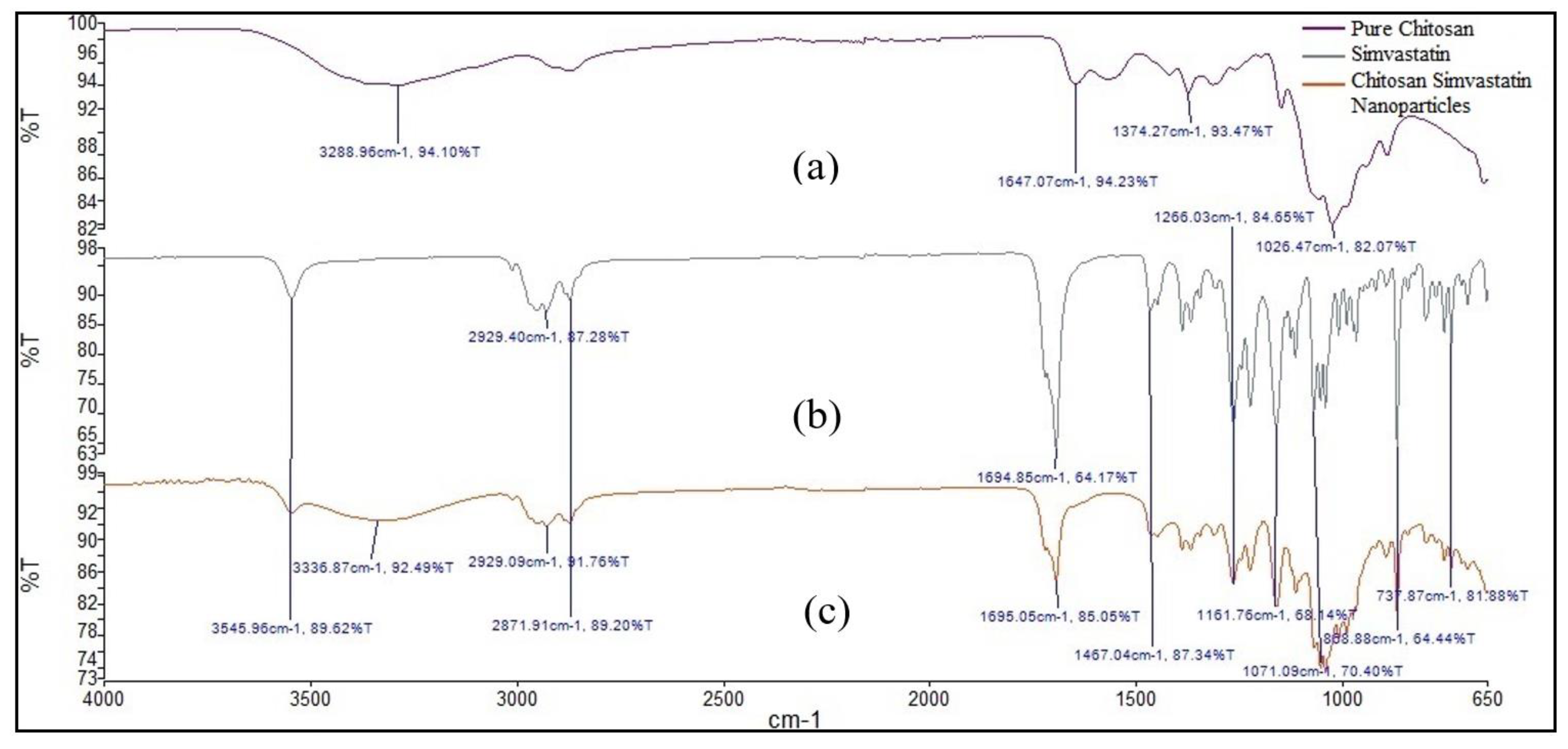
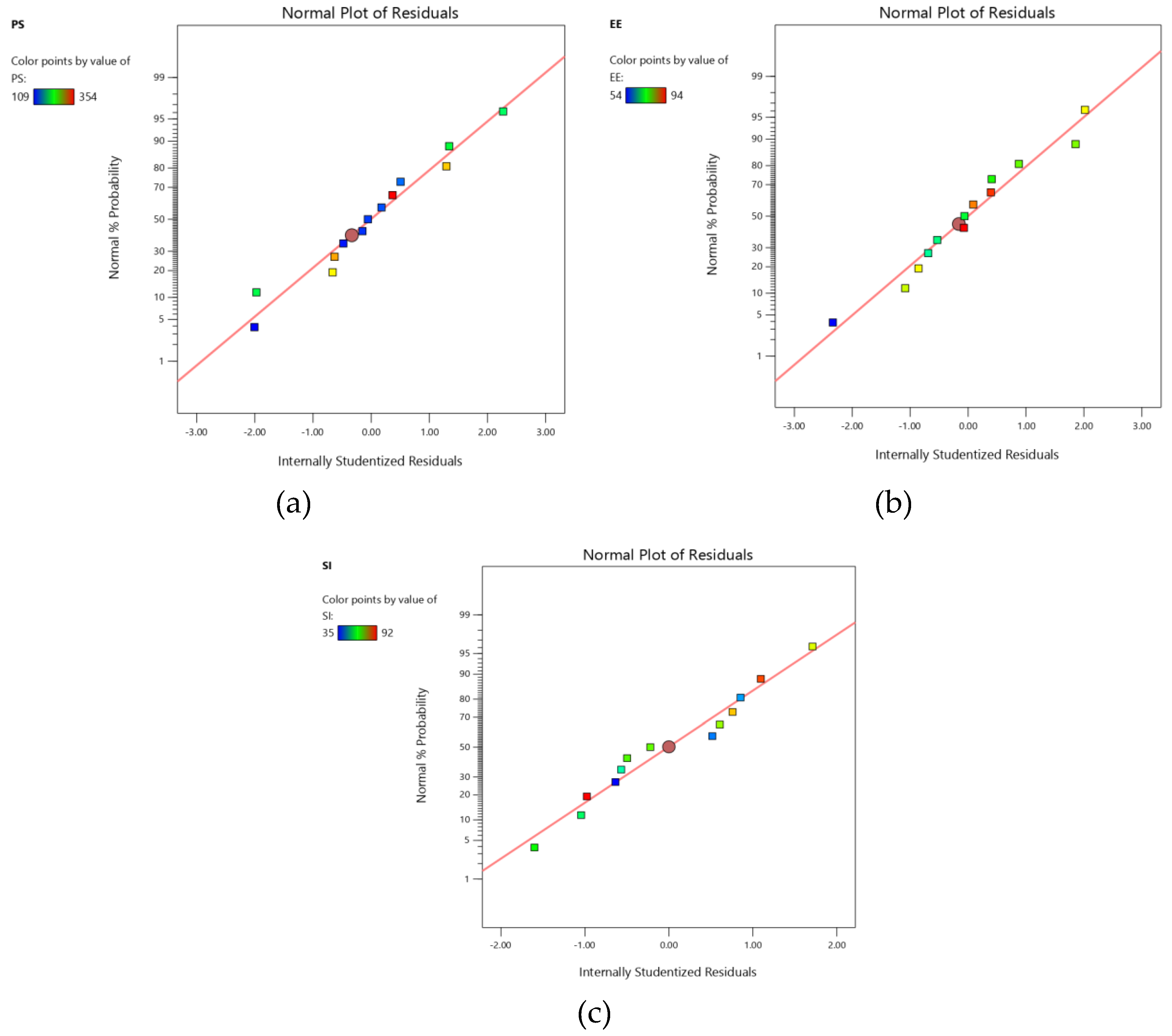
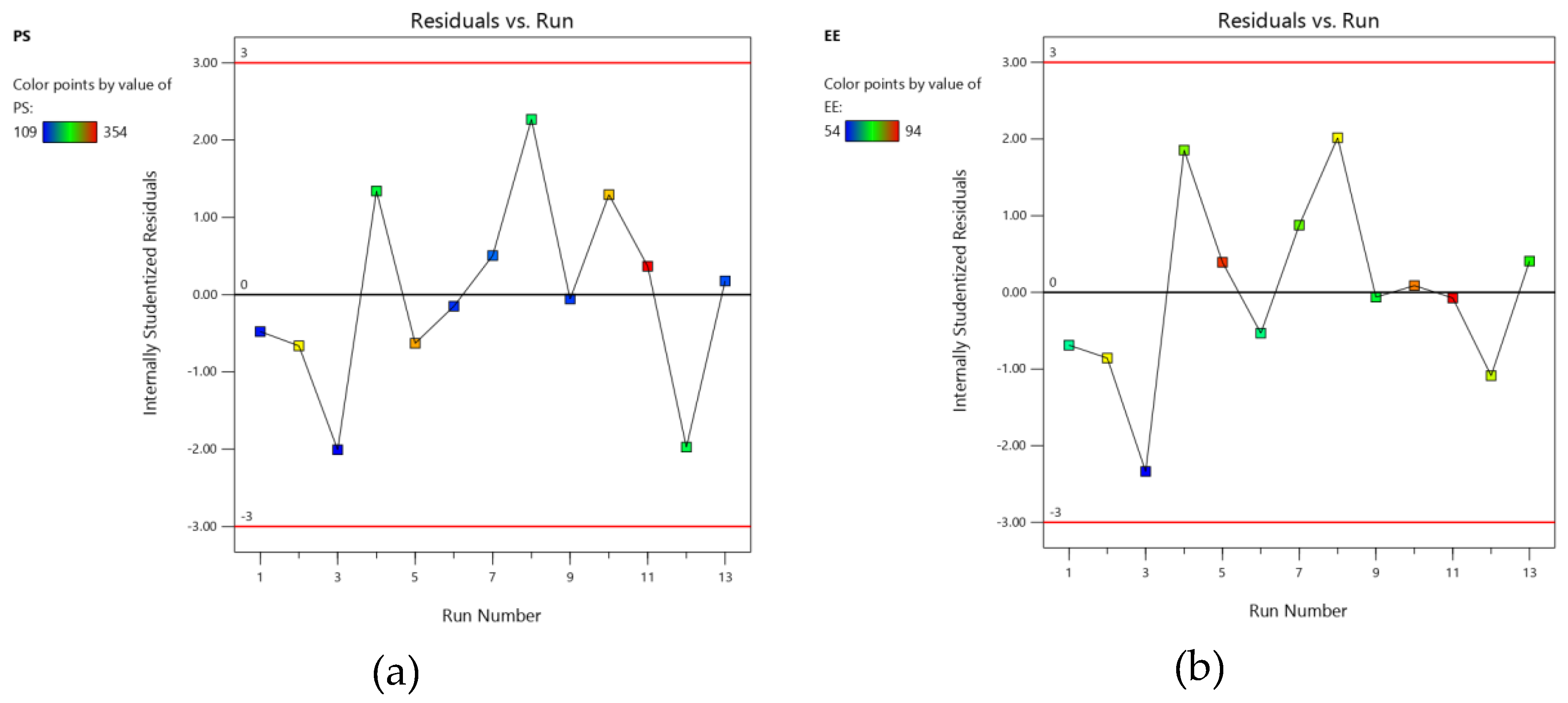
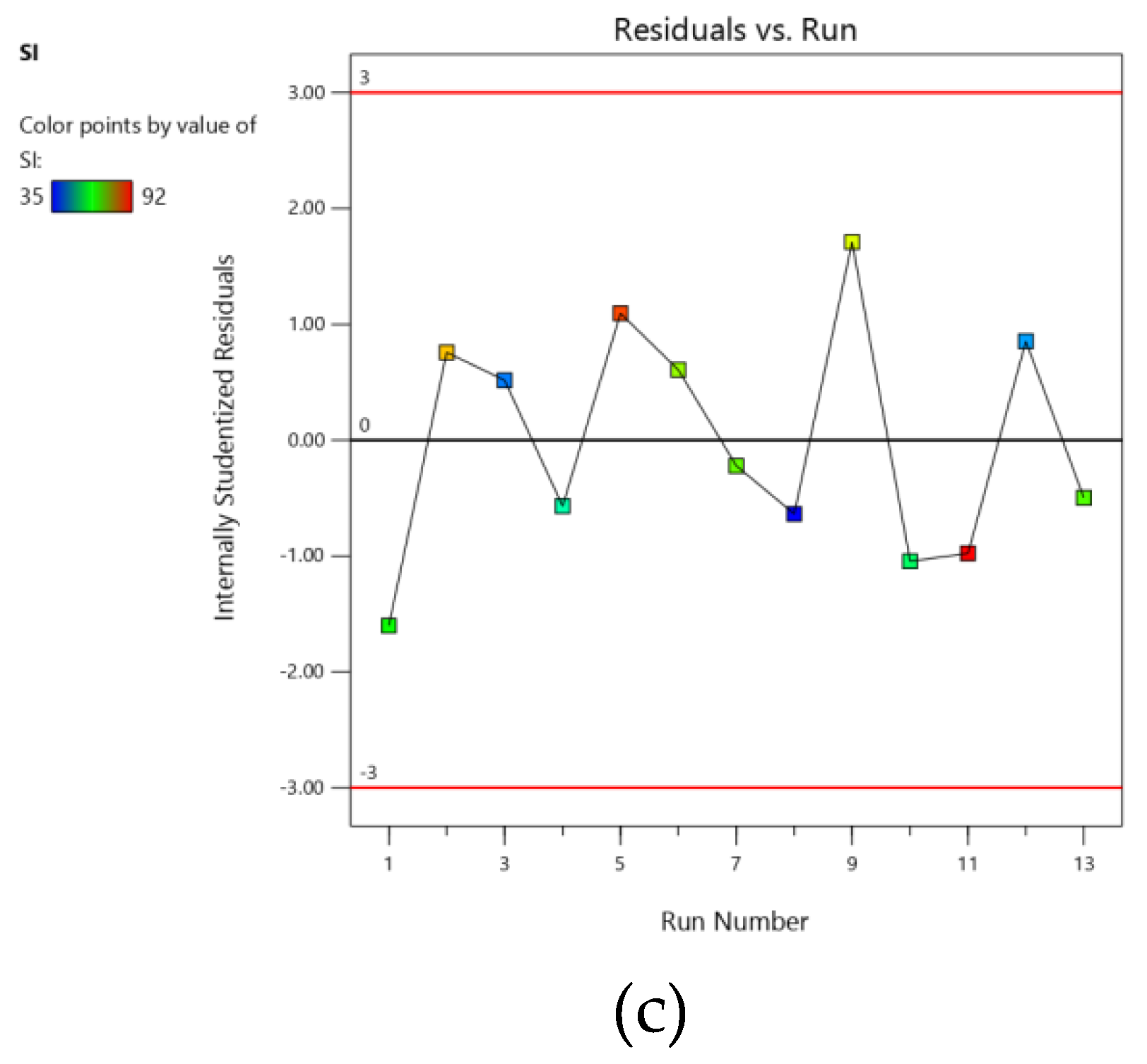
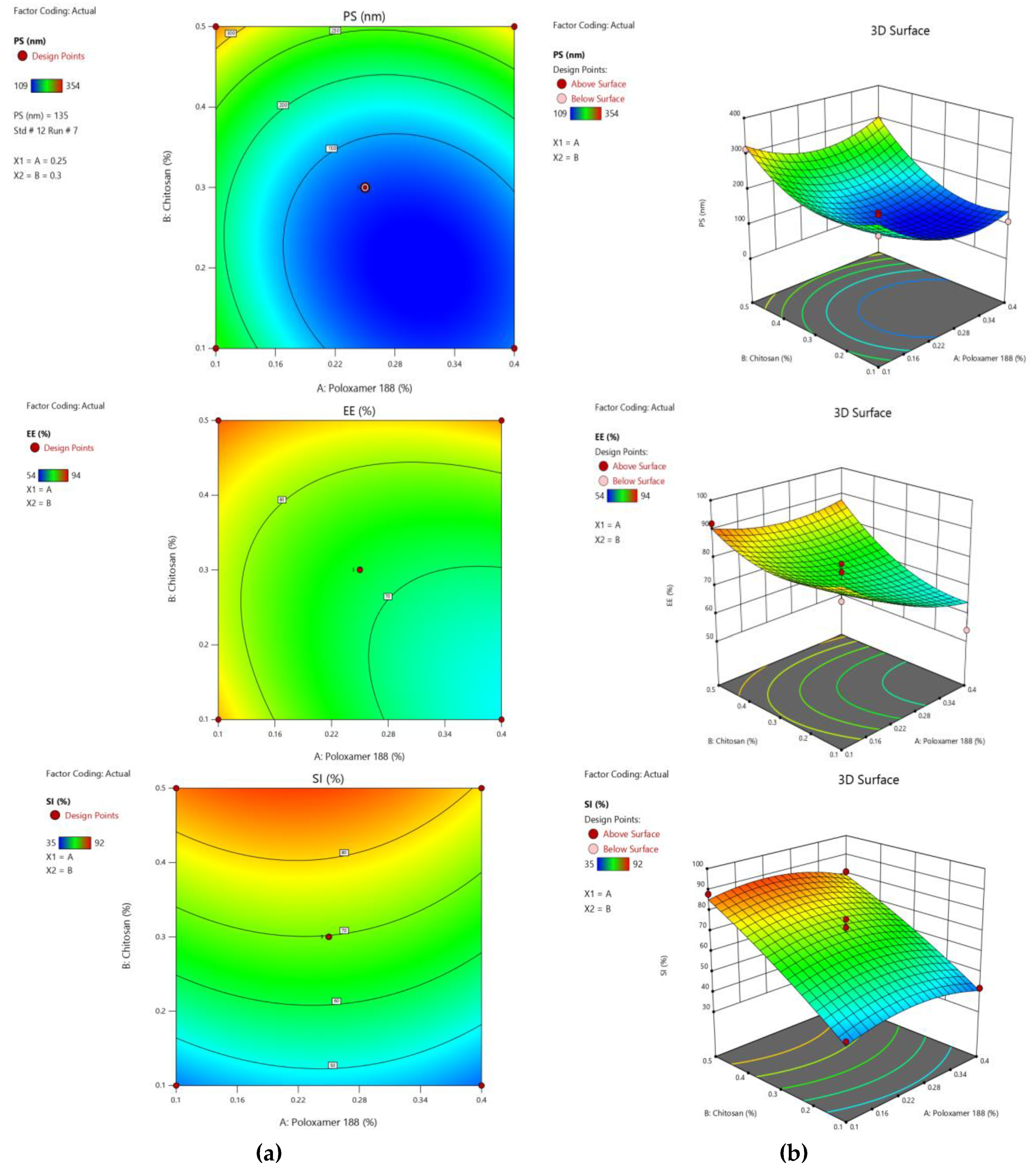

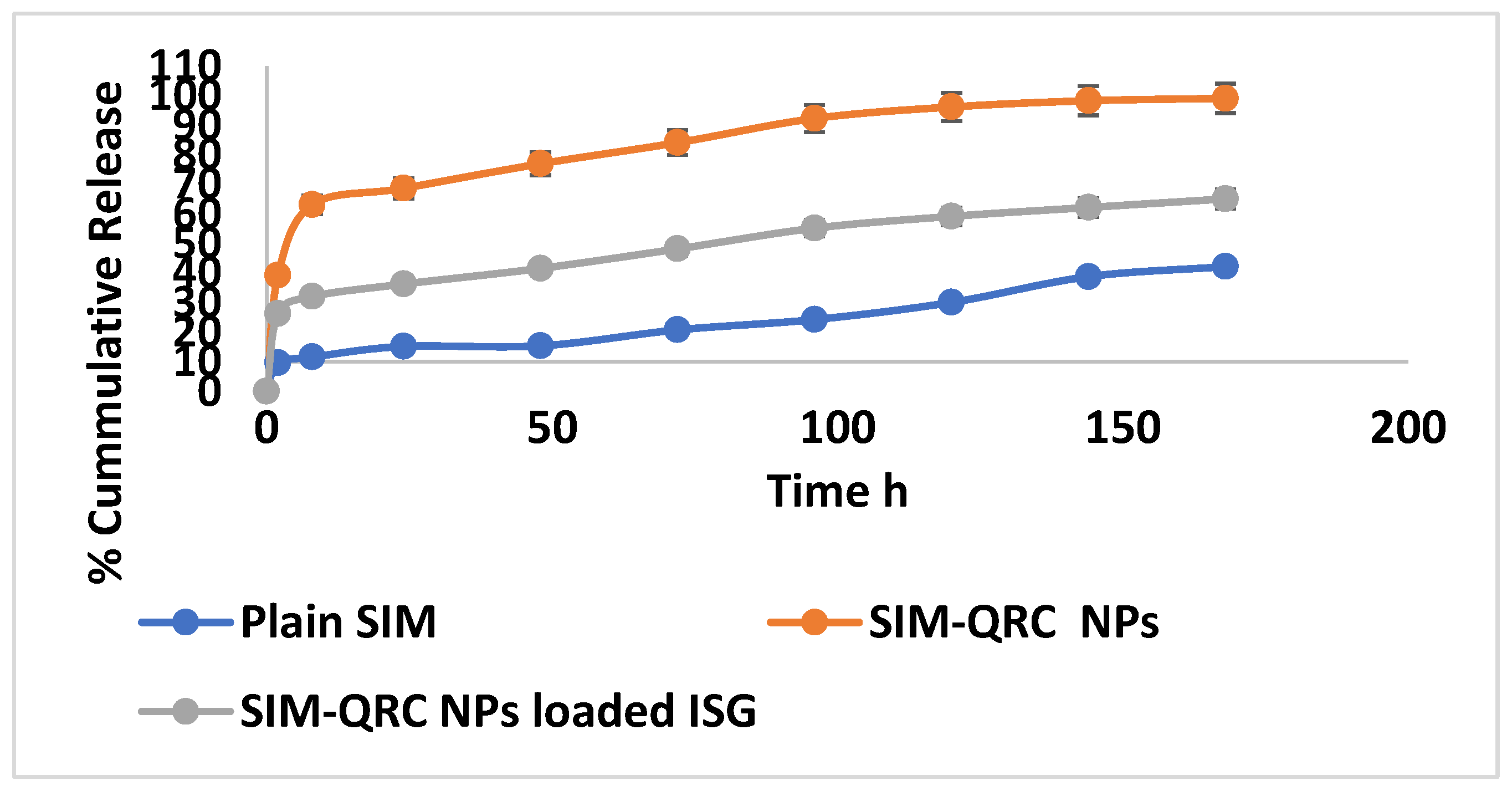
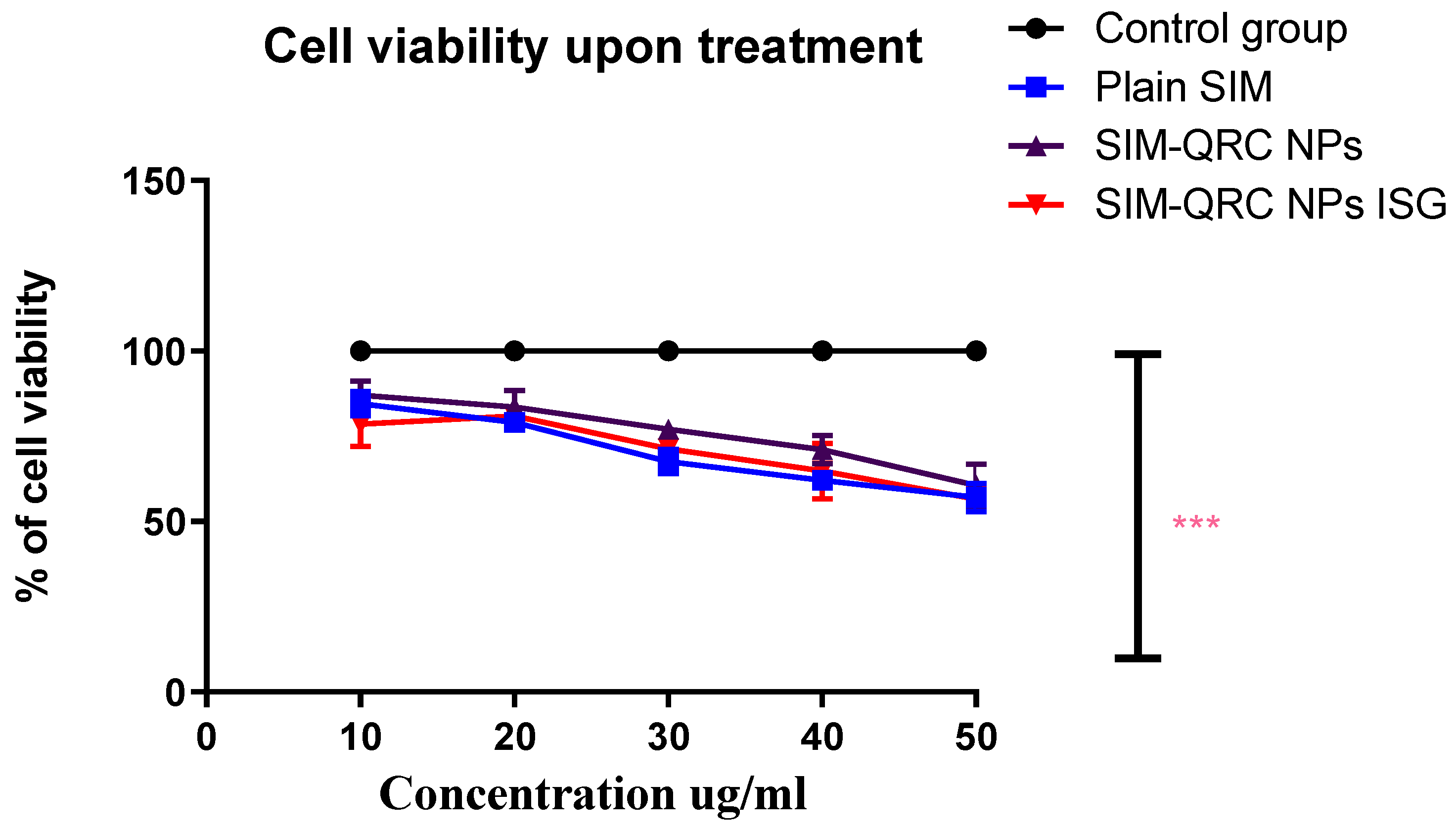
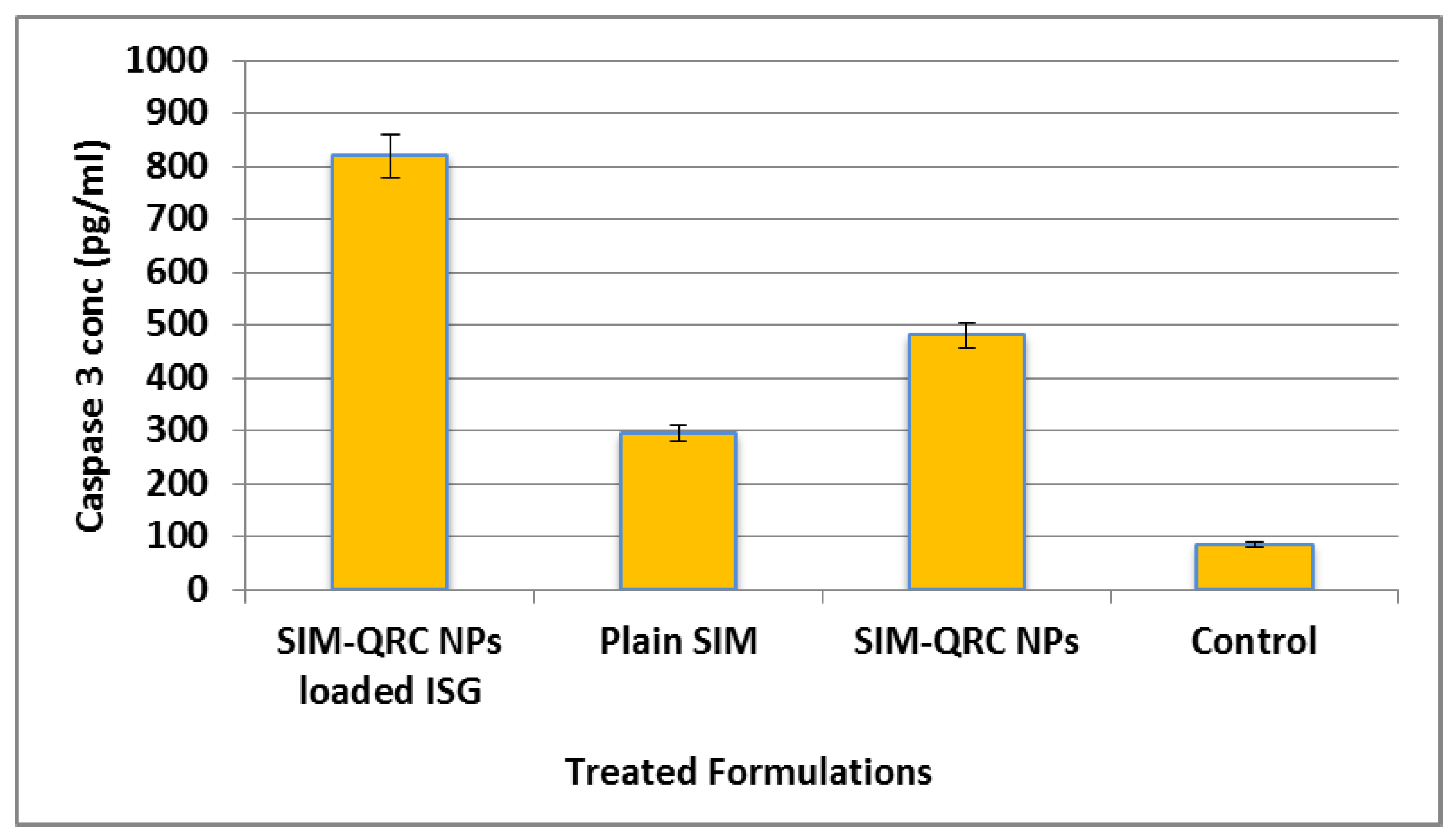
| Factor 1 | Factor 2 | Response 1 | Response 2 | Response 3 | |
|---|---|---|---|---|---|
| Run | A: Poloxamer 188 (%) | B: Chitosan (%) | PS (nm) | EE (%) | SI (%) |
| 1 | 0.25 | 0.3 | 114 | 68 | 64 |
| 2 | 0.4 | 0.5 | 294 | 84 | 81 |
| 3 | 0.4 | 0.1 | 109 | 54 | 42 |
| 4 | 0.462 | 0.3 | 218 | 79 | 54 |
| 5 | 0.1 | 0.5 | 314 | 92 | 88 |
| 6 | 0.25 | 0.3 | 121 | 69 | 72 |
| 7 | 0.25 | 0.3 | 135 | 78 | 69 |
| 8 | 0.25 | 0.017 | 208 | 84 | 35 |
| 9 | 0.25 | 0.3 | 123 | 72 | 76 |
| 10 | 0.037 | 0.3 | 305 | 89 | 58 |
| 11 | 0.25 | 0.582 | 354 | 94 | 92 |
| 12 | 0.1 | 0.1 | 214 | 82 | 44 |
| 13 | 0.25 | 0.3 | 128 | 75 | 68 |
| Factors | PS | EE | SI | |||
|---|---|---|---|---|---|---|
| F-Value | p-Value | F-Value | p-Value | F-Value | p-Value | |
| Model | 31.75 | 0.0001 * | 4.33 | 0.0408 * | 44.28 | <0.0001 * |
| A-Poloxamer 188 | 13.52 | 0.0079 * | 6.16 | 0.0421 * | 1.64 | 0.2417 |
| B-Chitosan | 53.07 | 0.0002 * | 7.18 | 0.0315 * | 203.83 | <0.0001 * |
| AB | 3.17 | 0.1180 | 1.96 | 0.2042 | 0.3807 | 0.5567 |
| A² | 42.60 | 0.0003 * | 1.84 | 0.2168 | 14.75 | 0.0064 * |
| B² | 57.83 | 0.0001 * | 5.20 | 0.0566 | 1.96 | 0.2044 |
| Lack of fit | 20.18 | 0.0871 ** | 5.55 | 0.0657 ** | 0.5629 | 0.6677 ** |
| Storage Conditions | Particle Size (nm) | Residual Drug Content (%) | ||||
|---|---|---|---|---|---|---|
| 0 Day | 15 Days | 30 Days | 0 Day | 15 Days | 30 Days | |
| 4.0 ± 1 °C | 194 ± 4.7 | 191 ± 3.1 | 191 ± 4.8 | 99.4 ± 0.41 | 98.6 ± 0.38 | 98.9 ± 0.28 |
| 25 ± 2 °C | 194 ± 3.4 | 193 ± 2.8 | 189 ± 3.2 | 99.4 ± 0.28 | 99.6 ± 0.27 | 99.0 ± 0.45 |
| Independent Variables | Code and Actual Levels | Dependent Variables | Constraints | ||||
|---|---|---|---|---|---|---|---|
| −1.141 | −1 | 0 | +1 | +1.141 | |||
| Concentration of Poloxamer 188 (%w/v) | 0.037 | 0.1 | 0.25 | 0.4 | 0.462 | Particle Size | Minimum |
| Concentration of Chitosan (%w/v) | 0.017 | 0.1 | 0.3 | 0.5 | 0.582 | EE | Maximum |
| Stability Index | Maximum | ||||||
© 2020 by the authors. Licensee MDPI, Basel, Switzerland. This article is an open access article distributed under the terms and conditions of the Creative Commons Attribution (CC BY) license (http://creativecommons.org/licenses/by/4.0/).
Share and Cite
Kurakula, M.; Naveen, N.R. In Situ Gel Loaded with Chitosan-Coated Simvastatin Nanoparticles: Promising Delivery for Effective Anti-Proliferative Activity against Tongue Carcinoma. Mar. Drugs 2020, 18, 201. https://doi.org/10.3390/md18040201
Kurakula M, Naveen NR. In Situ Gel Loaded with Chitosan-Coated Simvastatin Nanoparticles: Promising Delivery for Effective Anti-Proliferative Activity against Tongue Carcinoma. Marine Drugs. 2020; 18(4):201. https://doi.org/10.3390/md18040201
Chicago/Turabian StyleKurakula, Mallesh, and N. Raghavendra Naveen. 2020. "In Situ Gel Loaded with Chitosan-Coated Simvastatin Nanoparticles: Promising Delivery for Effective Anti-Proliferative Activity against Tongue Carcinoma" Marine Drugs 18, no. 4: 201. https://doi.org/10.3390/md18040201
APA StyleKurakula, M., & Naveen, N. R. (2020). In Situ Gel Loaded with Chitosan-Coated Simvastatin Nanoparticles: Promising Delivery for Effective Anti-Proliferative Activity against Tongue Carcinoma. Marine Drugs, 18(4), 201. https://doi.org/10.3390/md18040201




